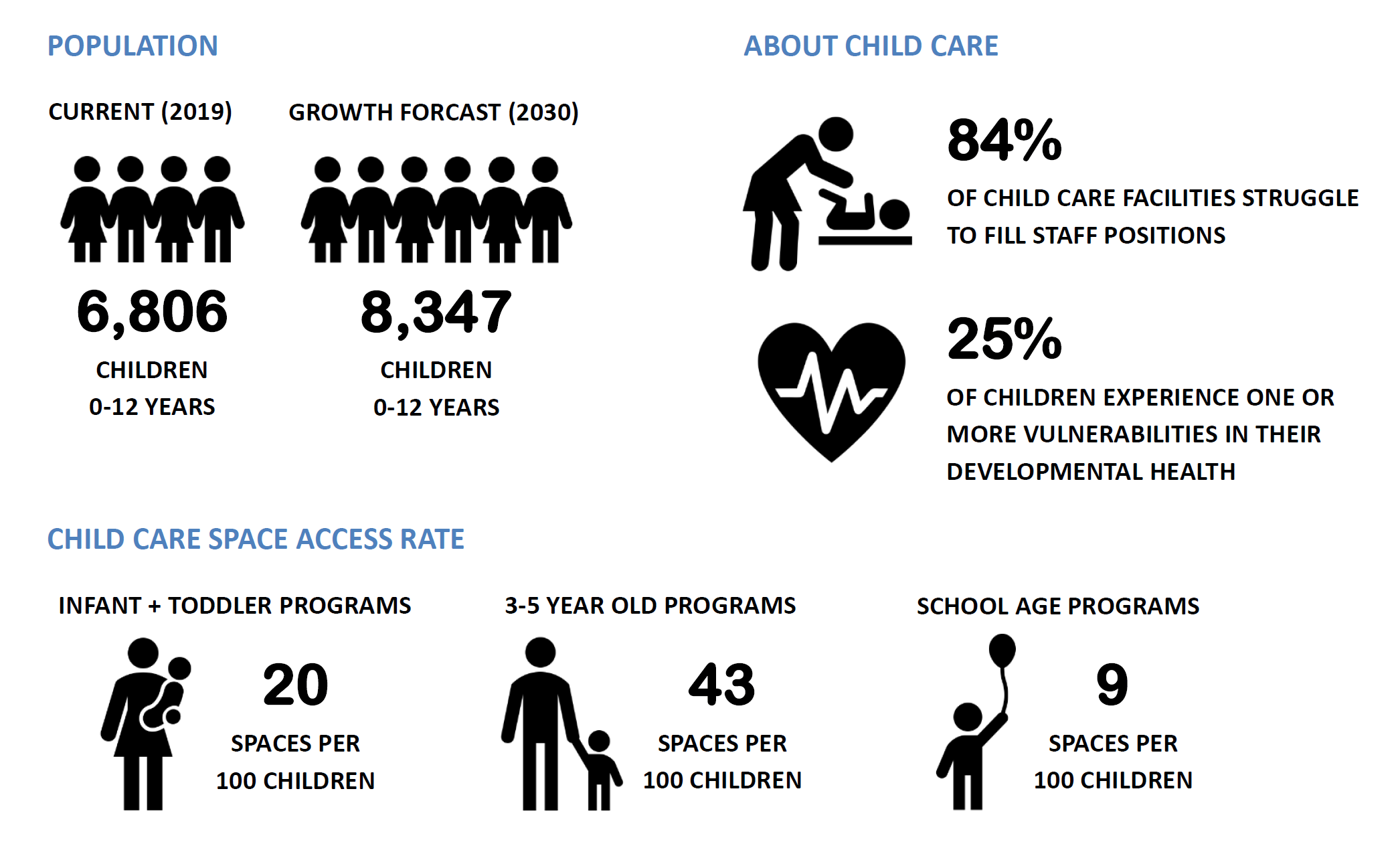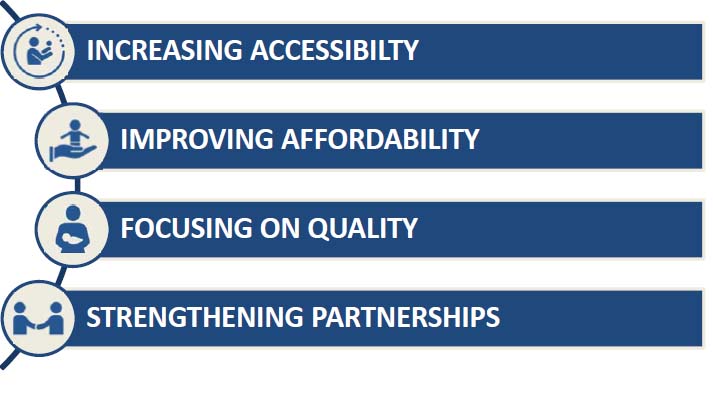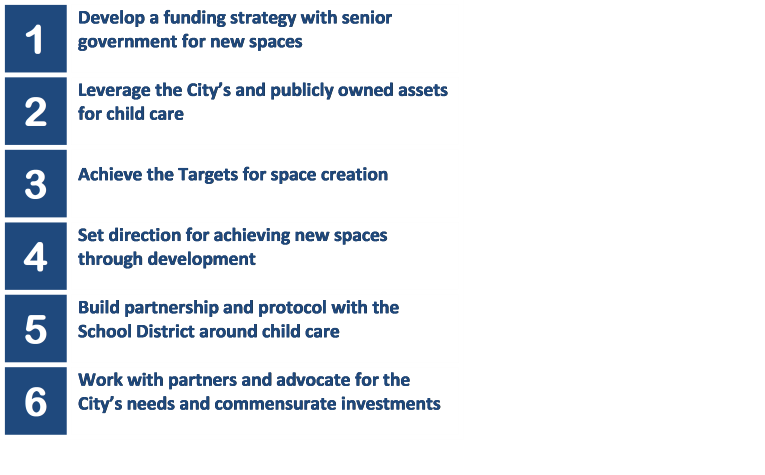Vision
To improve the accessibility, affordability, and quality of child care in the City over the next 10 years by collaborating with partners, creating new spaces, and advocating for the community’s needs.
Scope and Purpose
This is a 10-year plan that includes targets and actions for the short term (2021 to 2023), medium term (2024 to 2026), and long term (2027 to 2031).
As a local government the City does not have the mandate or resources to fully address the gaps in child care accessibility, affordability, and quality on its own. The mandate for early learning and child care is mostly provincial, with some federal involvement. Support from senior levels of government and strong partnerships with others are needed. This Plan defines the City’s priorities and actions to meet local child care needs.

Priorities

Priority Actions

Targets for creating additional child care spaces assist with planning and prioritization to meet community needs over the coming years.
To achieve the targets, local governments require support from senior levels of government, community partners, and others to address service gaps and to create new spaces. Given that the City does not have the mandate or resources to fully address the gaps in child care on its own, support from senior levels of government, and strong partnerships with others are needed. This Plan defines the City’s priorities and actions to meet child care needs.
The City's target is to create 1,063 new licensed child care spaces over the next 10 years (by 2031) as follows:
| Program Type |
Target for Average Access Rate by 2031 |
Number of Spaces Needed to Meet Target by 2031 |
| Infant and Toddler |
33 spaces per 100 children |
299 new spaces |
| Preschool (3-5 year olds) |
50 spaces per 100 children |
300 new spaces |
| School age (6-9 year olds) 1 |
33 spaces per 100 children |
464 new spaces |
_________________________________
1 Note that the target for School Age Programs includes children aged 6-9 years old (not 6-12 year old). It is recognized that 10-12 year olds can more easily and preferably access other non-licensed opportunities before and after school.
Use the North Shore Child Care Directory tool to explore licensed and registered child care providers across the North Shore.
Contact North Shore Child Care Resource and Referral to discuss your child care needs.
Interested in opening a child care facility in the City of North Vancouver? Refer to the information provided on this page to help you get started. Please do not commit to a property before you get all the required approvals. A new child care facility requires a licence from Vancouver Coastal Health (VCH), a business licence from the City, and in some cases a building permit for renovations.
-
Check that the zoning for the property allows “Child Care” as a use
Conduct initial research on your property’s zoning to ensure child care is a supportable use. You can determine the zoning of any property in the City using the “Property Report” function within our interactive CityMap tool.
“Child Care Use” as defined as in the City’s Zoning Bylaw, 1995, No. 6700 means “a
facility providing care for children, including an opportunity for social, emotional, physical
and intellectual growth, which is licensed under the Child Care Regulations made
pursuant to the Provincial Childcare Licensing Regulations.”
If your site’s zoning does not include Child Care Use, you might be able to submit a
rezoning application to allow the use. Please contact planning staff through
gateway@cnv.org to enquire about the process, and see more information on our Land
Use Approvals page.
If you have questions regarding our CityMap tool or zoning, please email gateway@cnv.org or call 604-982-WORK (9675).
-
Start your application with Vancouver Coastal Health (VCH)
In addition to City requirements, the local health authority Vancouver Coastal Health (VCH) also regulates child care facilities. Your application for a new child care licence starts with VCH, and you will need to work closely with them throughout the application process. See the VCH website for more information on their requirements.
VCH staff will conduct an initial assessment of your property and proposal, and will then refer your application to the City’s Business Licence Division.
-
VCH Referral and Apply for a City Business Licence
With VCH’s referral, the City’s Business Licence Division will intake your Business Licence Application. During this stage, staff will review the property’s zoning and may require further documentation to support their review, which could include preliminary floor plans. If the application complies with the respective Zoning requirements, you’ll receive a letter from the Business Licensing Division confirming next steps.
-
Apply for a Building Permit.
If you do any renovations, alterations, additions, or changes in use or occupancy to the building, you must obtain permits. Construction may only start after the proper permits have been issued. Retain the services of a registered professional to assist with the design and modifications to the building in order to meet the requirements of the BC Building Code. For child care applications of 8 or more children, VCH will need to review and stamp the building permit drawings before you submit them to the City as part of your Building Permit submission.
-
Do the required Building Upgrades and complete Final Inspections.
With your issued permit(s), you may proceed with the required building upgrade works in consultation with your registered professionals. Building Officials will monitor the work to ensure conformance with the accepted plans.
-
Get VCH Licence and open your child care facility!
After all required construction is complete, and the permits and inspections are done, both VCH and the City will be able to issue your final business licences. Then you are ready to go!
Residential Areas
Child Care Uses in residential zones can typically be permitted as either as a principal use or more commonly, as an accessory use to a principal use. A principal Child Care Use means the primary land use of the property is to provide Child Care services, whereas an Accessory Child Care Use is only permitted as an accessory use to a principal residence.
Principal Child Care Uses in residential zones are usually only in the Apartment Residential Zones (ex. RG-1, RM-1, and RH-1), subject to meeting the restrictions outlined under Section 507(5) of the Zoning Bylaw.
Accessory Child Care Uses are generally a permitted in most residential-zoned areas (ex. RS-1, RT-1, etc.) similar to our provisions on Accessory Home Office uses. Accessory Child Care uses must comply with the restrictions outlined under Section 507(8) of the Zoning Bylaw. This section again clarifies that a child care cannot be the principal use for a property, including further requirements such as:
- No more than 16 children in care at any one time;
- Must be operated by a resident living on the property;
- Not permitted on a property already containing a secondary suite, boarding use, coach house use, or another home occupation use;
- 1 additional on-site parking space is required for an accessory child care. This is not required for child care businesses of 8 or less children.
Please review Sections 507(5) or 507(8) in full as part of your initial research into your prospective property. Note that Primary Child Care Use limits the maximum amount of children to 20 and requires a minimum of 3 on-site parking spaces. Note: in addition to the Zoning requirements, there are also separate VCH requirements. See their website for more information.
Regardless of the distinction between primary and accessory, the City’s review process may vary depending on the size of the proposed residential child care facility, as described below and summarised in this flowchart:
-
8 or less children
Family child care will be subject to standard life safety inspections as part of the Business Licencing process.
-
9-12 children
This amount of children is defined as a standard “Child Care Facility” bound by Section 509 of the CNV Business Licence Bylaw No. 8640 – which requires you to provide a Traffic Management Plan. As per that Section, a Council approval process and Public Meeting may be required if one or more of the conditions outlined under Section 509(2) apply.
You will be responsible for retaining the services of a qualified building professional to design, permit and construct any upgrades required to meet the BC Building Code. Life safety inspections as part of the Business Licencing process are also required.
-
13-16 children
A Council approval process is required, as described for Group Child Care Facilities (Section 515) of the CNV Business Licence Bylaw No. 8640.
You will be responsible for retaining the services of a qualified building professional to design, permit and construct any upgrades required to meet Building Code. Life safety inspections as part of the Business Licencing process are also required.
Existing Commercial, Industrial, or Institutional Buildings
Child Care Use is typically permitted in most commercial, industrial and institutional zoned areas in the Zoning Bylaw, 1995 No. 6700, through the definition of Retail-Service Group 1 Use. For most non-residential Child Care Uses, Section 607(9) of the Zoning Bylaw would generally apply. Note that the on-site parking requirements associated with Child Care will vary depending on the building classification as outlined under Figure 9-3 of the Zoning Bylaw. You are welcome to contact the City’s Planning Department should you have any questions about the Zoning.
As with any child care application, both the City’s regulations and VCH’s requirements would apply, as determined per proposal. One of the challenges child care operators can face when retrofitting existing buildings is meeting VCH’s standard outdoor space requirements. Consult with VCH staff to understand whether your proposal will meet VCH licensing requirements.
The number of children permitted will be based on both the BC Building Code and Vancouver Coastal Health (VCH) requirements. You will be responsible for retaining the services of a qualified building professional to design, permit and construct any upgrades required to meet Building Code.
New and Redeveloped Buildings
If you are considering integrating child care as part of a new Planning application (for example, through a comprehensive rezoning), you are encouraged to submit a Pre-Consultation Application. Through that application, staff will conduct a high-level review to provide general direction on the viability of a child care facility in respect to your proposed redevelopment.
As always though, we encourage you discuss your redevelopment proposal with VCH early on given that they will be the ultimate licensing authority.
Information on the Pre-Consultation Application as well as the ensuing Planning application process is provided on our website.